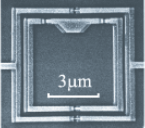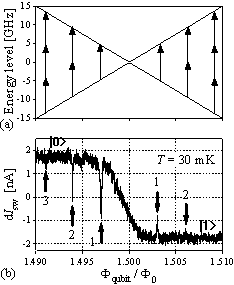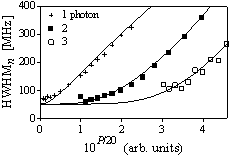Masahito Ueda2, and Hideaki Takayanagi
Materials Science Laboratory, Heinrich-Heine-Universitat Dusseldorf1,
NTT Research Professor and Tokyo Institute of Technology2
Of the recently realized solid-state quantum bits (qubits), the superconducting
flux qubit has advantages because its scalability and long coherence time.
The qubit consists of a superconducting loop with three Josephson junctions
(see Fig. 1). The two states of the qubit correspond to clockwise |0> and
counterclockwise |1> superconducting current in the loop. The current involves
millions of Cooper pairs, which means that the two states are macroscopically
distinct. Hence, this system can realize a superposition between two such
macroscopic states. For the first time, we observed multiphoton transitions
between the superposition states in the superconducting flux qubit [1].
Figure 2(a) shows the magnetic flux dependence of the qubit energy levels,
where ![]() is the flux through the qubit loop and
is the flux through the qubit loop and ![]() (=
(=
![]() )
is the flux quantum. The arrows in the figure represent a microwave with an
energy of 9.1 GHz. The qubit can be excited from the ground state to the first
excited state by absorbing multiple photons. We remark that the existence
of the energy gap at the degeneracy point
)
is the flux quantum. The arrows in the figure represent a microwave with an
energy of 9.1 GHz. The qubit can be excited from the ground state to the first
excited state by absorbing multiple photons. We remark that the existence
of the energy gap at the degeneracy point ![]() =1.5
is strong evidence for the superposition between the macroscopically distinct
states.
=1.5
is strong evidence for the superposition between the macroscopically distinct
states.
The qubit was read out by measuring the switching current of a superconducting
quantum interference device (dc-SQUID) (see Fig. 1). Figure 2(b) shows the
![]() change in the switching current as a function of the magnetic flux under the
microwave irradiation. The dc-SQUID detected the change in the qubit state
from |0> to |1> induced by magnetic flux. Furthermore, resonant peaks
and dips were observed at the expected operating points in Fig. 2(a). The
microwave power dependences of the half width at half maxima of the resonant
dips were well reproduced by Bloch equations based on a dressed-atom description
(see Fig. 3). From this analysis, we found the qubit coherence time to be
5 ns, which is consistent with that obtained from another experiment using
a microwave pulse.
change in the switching current as a function of the magnetic flux under the
microwave irradiation. The dc-SQUID detected the change in the qubit state
from |0> to |1> induced by magnetic flux. Furthermore, resonant peaks
and dips were observed at the expected operating points in Fig. 2(a). The
microwave power dependences of the half width at half maxima of the resonant
dips were well reproduced by Bloch equations based on a dressed-atom description
(see Fig. 3). From this analysis, we found the qubit coherence time to be
5 ns, which is consistent with that obtained from another experiment using
a microwave pulse.
[1] S. Saito, et al., cond-mat/0403425.
 |
|
 |
||||||||
 |
||||||||||
|
|
|||||||||